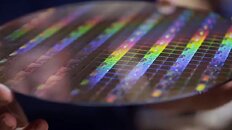Sunday, August 30th 2020

Intel 11th Gen Core "Tiger Lake" Promotional Videos Leak
Promotional videos of Intel 11th Gen Core "Tiger Lake" processors leaked to the web courtesy h0x0d on Twitter. It confirms the new corporate identity of Intel, along with its new logo artistic language. It also confirms the new EVO Powered by Core brand extension, along with a separate case badge for notebooks that use Iris Xe discrete graphics (DG1) in addition to the Xe Gen12 iGPU of "Tiger Lake." Intel has a technology that can get the Xe LP iGPU and dGPU to work in tandem. VideoCardz compiled some interesting frames from the promotional videos, revealing bits such as clock speeds of up to 4.80 GHz (boost), 3.11 GHz (base), the first "Tiger Lake" parts being 4-core/8-thread, the new 10 nm SuperFin transistor, wafer- and die shots of "Tiger Lake" 4c+96EU die, and unless we're mistaken, pictures of a "Tiger Lake" package that uses a DRAM (HBM?) stack on-package, using EMIB. h0x0d also posted videos of the Lenovo Yoga 9i and HP Spectre notebooks based on "Tiger Lake."
Sources:
h0x0d (Twitter), VideoCardz




12 Comments on Intel 11th Gen Core "Tiger Lake" Promotional Videos Leak
if it's the images of the CPU+southbridge package or the PCB layout, neither are indicative of HBM and Intel has been packaging their southbridge into the substrate since at least the 4th gen Core-i CPUs (U series; and the first gen Core-i had a few versions which put the Northbridge on the package [modern phrase: chiplet I/O die with integrated graphics processor]).
Either way, other leaks indicate the U series are getting stuck with 4 cores, again. Intel couldn't even spot one more core in there, eh? Oh, well. Nobody said Intel had to win vs AMD. 2nd place/loser is an acceptable position for Intel, and one they should get used to.
I wonder how this will fly for them. But new logo's dont win benchmarks.
Linus Torvalds: "I hope AVX512 dies a painful death, and that Intel starts fixing real problems instead of trying to create magic instructions to then create benchmarks that they can look good on."
Maybe the corporate
disguiseidentity will help them this time :roll::roll: It really is entertaining to watch them twist and turn around reality and the inevitable upcoming slaughter of their biglittle concept.Increasing IPC in a core means one thing. That core will get fatter and fatter and fatter and you can gate it and turn it off so muchuntil you hit a wall and that is your lowest wattage.
So if AMD or Intel want to double their IPC in the next 5 years (and they need to do it since Apple A14 big core might just have the same IPC as Zen 2 and Skylake), they simply have no other choice than go big little if they wanna keep especially power in check.
And don't forget than AMD Zen 2 core is a relatively modest core in terms of IPC. It is 5-10% better than Skylake which is a core from 2015.
AMD is adding more and more IPC, Zen 3 will be 20% better, Zen 4 hopefully the same or more. All that extra IPC means more units, more power, so they will be forced to go big little as well, unless they find some other technical idea/solution for this problem.
I'm not a fan of it, and don't believe it belongs on the desktop, since this puts a tremendous burden on the OS scheduler to manage it well, possibly to the extent where the OS needs a firmware module per CPU microarchitecture like on ARM.
There is also a risk that this will end up only looking well in synthetic benchmarks but induce terrible latency in reality."Fatter" in terms of transistors, yes, but not necesassarily in terms of die space.
Die sizes:
Sandy Bridge: 18.5 mm²
Skylake: 8.7 mm²
Ice Lake: 6.9 mm²
At the moment, we're hitting a clock speed wall, and will continue to do so until we get wastly different materials. So any architectural improvement which can yield a substantial IPC gain is worth it. As we can see with Intel's 14nm, it remains very energy efficient at ~4 GHz, but gets terribly inefficient at >4.5 GHz. So trading off some max boost clocks for higher IPC is certainly a good idea.Perhaps for mobile devices.
But there are substantial improvements coming down the line. Significant IPC gains may also help energy efficiency, at least for demanding threads. Small cores only makes sense for non-demanding threads.IPC is Instructions Per Clock, not performance per clock. Comparing IPC across ISAs is completely pointless. ARM needs more instructions to do the same amount of work, especially compared to advanced x86 instructions which can eliminate a lot of branching logic. A RISC design will never be able to compete with x86 in this way.Actually not. Zen 2 wins with heavy multithreaded workloads because Skylake have to throttle due to the inferior node, resulting in Skylake running much lower clocks than advertised for heavy multithreaded workloads.I certainly hope Zen 3 and Zen 4 will push the performance levels forward, but I don't think it's an established fact that Zen 3 will offer "20%" more performance, and under which conditions.
I don't know what architectural innovations AMD have in store, but apparently Golden Cove (Sapphire Rapids) is "significantly bigger" than Sunny Cove (Ice Lake), and Intel are working on things like "threadlets" and ISA improvements. We are nowhere near a theoretical limit in single core speed, but it's a balancing act. For Haswell and Skylake Intel prioritized SIMD performance and cache bandwidth, benefiting many workloads substantially, while others got minimal gains. Going forward, we should expect both AMD and Intel to create more advanced front-ends, more execution ports with more ALUs and FPU/vector units, etc.
This should also stoke some fear into Nvidia / AMD about their dGPU lineups.